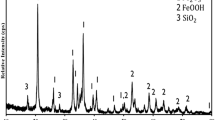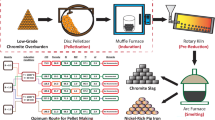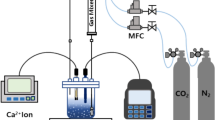Abstract
The purpose of smelting is to enrich most of the copper in the copper concentrate in the matte phase. The gangue, oxides and impurity elements were combined in the slag phase to completely separate the copper matte in the slag phase. In this paper, a mathematical model based on the optimization of copper concentrate cost and the content of impurity elements in the mixed copper concentrate is constructed for the copper concentrate dosing calculation. The model is solved using a particle swarm optimization algorithm to obtain the mixed copper concentrate blending results. Melting prediction of the blending results is carried out by optimizing the neural network via the particle swarm optimization algorithm to realize production prediction from the copper concentrate blending to the melting results.






Similar content being viewed by others
References
F. Wang, J.F. Xiang, Y.F. Guo, and F.Q. Zheng, J. Iron Steel Res. 32, 89 (2020).
T. Peng, Sulphur Phosphorus Bulk Mater. Handl. Relat. Eng. 3, 44 (2014).
C.B. Zheng, H.L. Wang, and F.M. Zhang, Copp. Eng. 130, 74 (2014).
M.Y. Kou, Z. Zhang, W. Zeng, H. Zhou, and S.L. Wu, Iron Steel 57, 1 (2022).
J. Hu, M. Wu, L. Chen, W. Cao, and W. Pedrycz, J. Process Control 111, 97 https://doi.org/10.1016/j.jprocont.2022.02.002 (2022).
W.S. Liu, and F.P. Li, Appl. Mech. Mater. 443, 657 https://doi.org/10.4028/www.scientific.net/AMM.443.657 (2013).
K.K. Bai, A.J. Zhang, H.B. Zuo, J.J. Zuo, and Y.Z. Pan, Nonferrous Met. Sci. Eng. 10(3), 1 https://doi.org/10.13264/j.cnki.ysjskx.2019.03.001 (2019).
L.H. Ke, X.Z. He, Y.C. Ye, and Y.Y. He, China Min. Mag. 26(01), 77 (2017).
D.H. Zhang, Modern Metall. 41(03), 78 (2013).
Z.G. Li, and Z.Q. Cui, J. Guangxi Univ. Nat. Sci. Ed. 38(05), 1230 https://doi.org/10.13624/j.cnki.issn.1001-7445.2013.05.010 (2013).
N. Li, H.W. Ye, H. Wu, L.G. Wang, T. Lei, and Q.Z. Wang, Min. Res. Dev. 39(02), 16 (2019).
Q. Feng, Q. Li, Y.-Z. Wang, and W. Quan, Control Theory Appl. 2021, 1 (2021).
C.H. Yang, M. Xie, W.H. Gui, and X.B. Peng, Inf. Control 37, 28 (2008).
X.-H. Fan, Y. Li, and X.-L. Chen, Energy Procedia 16, 769 https://doi.org/10.1016/j.egypro.2012.01.124 (2012).
S.B. Yang, T.J. Yang, and Y.C. Dong, Chin. J. Eng. 18(03), 220 (1996).
J.K. Song, World Nonferrous Met. 06, 11 (2021).
J.H. Ji, M.Y. Ma, and R.Q. Chang, J. Univ. Sci. Technol. Liaoning 44(02), 129 https://doi.org/10.13988/j.ustl.2021.02.009 (2021).
C.Y. Liu, J.C. Ling, L.H. Kou, L.X. Qiu, and J.Q. Wu, Chin. J. Health Stat. 30(02), 173 (2014).
J. Hu, M. Wu, X. Chen, S. Du, W. Cao, and J. She, Inf. Sci. 483, 232 https://doi.org/10.1016/j.ins.2019.01.027 (2019).
B. Zhang, J. Zhou, and M. Li, Appl. Therm. Eng. 131, 70 https://doi.org/10.1016/j.applthermaleng.2017.11.148 (2018).
Q.H. Gu, Q.Q. Meng, C.W. Lu, and L. Ma, Min. Res. Dev. 39, 16 https://doi.org/10.13827/j.cnki.kyyk.2019.02.004 (2019).
S.-L. Wu, D. Oliveira, Y.-M. Dai, and J. Xu, Int. J. Miner. Metall. Mater. 19, 217 https://doi.org/10.1007/s12613-012-0541-2 (2012).
Y.K. He, Sci. Tech. Dev. Enterp. 13, 132 (2014).
S.-L. Wu, X.-B. Zhai, L.-X. Su, and X.-D. Ma, J. Iron. Steel Res. Int. 27, 755 https://doi.org/10.1007/s42243-019-00318-7 (2019).
B.-J. Yan, J.-L. Zhang, H.-W. Guo, L.-K. Chen, and W. Li, Int. J. Min. Metall. Mater. 21, 741 https://doi.org/10.1007/s12613-014-0966-x (2014).
Q.L. Xiang, M. Wu, B. Hou, and J. Xiang, J. Shandong Univ. (Eng. Sci.) 35(04), 43 (2005).
K.S. Barros, V.S. Vielmo, B.G. Moreno, G. Riveros, G. Cifuentes, and A.M. Bernardes, Minerals. https://doi.org/10.3390/min12020250 (2022).
A. Anderson, V. Kumar, V.M. Rao, and J. Grogan, JOM 74, 1543 https://doi.org/10.1007/s11837-022-05169-4 (2022).
Z.L. Ye, Q.K. Chen, H.P. Zhang, Y.F. Zhu, S.W. Zhou, B. Li, and Z. Shi, J. Kunming Univ. Sci. Technol. (Nat. Sci.) 47(01), 7 (2022).
A.F. Mulaba-Bafubiandi, Hyperfine Interact. 168, 923 https://doi.org/10.1007/s10751-006-9398-y (2006).
X.H. Yu, and C.X. Sun, J. Henan Inst. Educ. (Nat. Sci. Ed.) 30(04), 21 (2021).
Z.H. Wang, D.Y. Gong, G.T. Li, and D.H. Zhang, J. Northeastern Univ. (Nat. Sci.) 39(12), 1717 (2017).
K. Han, and S.Y. Li, J. Railw. Sci. Eng. 17, 2216 https://doi.org/10.19713/j.cnki.43−1423/u.T20191095 (2020).
R. Wang, S.W. Bai, and W.C. Dang, J. Taiyuan Univ. Sci. Technol. 42(06), 469 (2021).
S. Mirjalili, S.M. Mirjalili, and A. Lewis, Adv. Eng. Softw. 69, 46 https://doi.org/10.1016/j.advengsoft.2013.12.007 (2014).
Acknowledgements
This work was supported by the National Natural Science Foundation of China (51974142).
Author information
Authors and Affiliations
Corresponding author
Ethics declarations
Conflict of interest
The authors declare that they have no known competing financial interests or personal relationships that could have appeared to influence the work reported in this paper.
Additional information
Publisher's Note
Springer Nature remains neutral with regard to jurisdictional claims in published maps and institutional affiliations.
Supplementary Information
Below is the link to the electronic supplementary material.
Rights and permissions
Springer Nature or its licensor (e.g. a society or other partner) holds exclusive rights to this article under a publishing agreement with the author(s) or other rightsholder(s); author self-archiving of the accepted manuscript version of this article is solely governed by the terms of such publishing agreement and applicable law.
About this article
Cite this article
Wang, G., Zhou, S., Li, B. et al. Copper Concentrate Blending and Melting Prediction Based on Particle Swarm Optimization Algorithm. JOM 75, 4350–4360 (2023). https://doi.org/10.1007/s11837-023-06016-w
Received:
Accepted:
Published:
Issue Date:
DOI: https://doi.org/10.1007/s11837-023-06016-w




